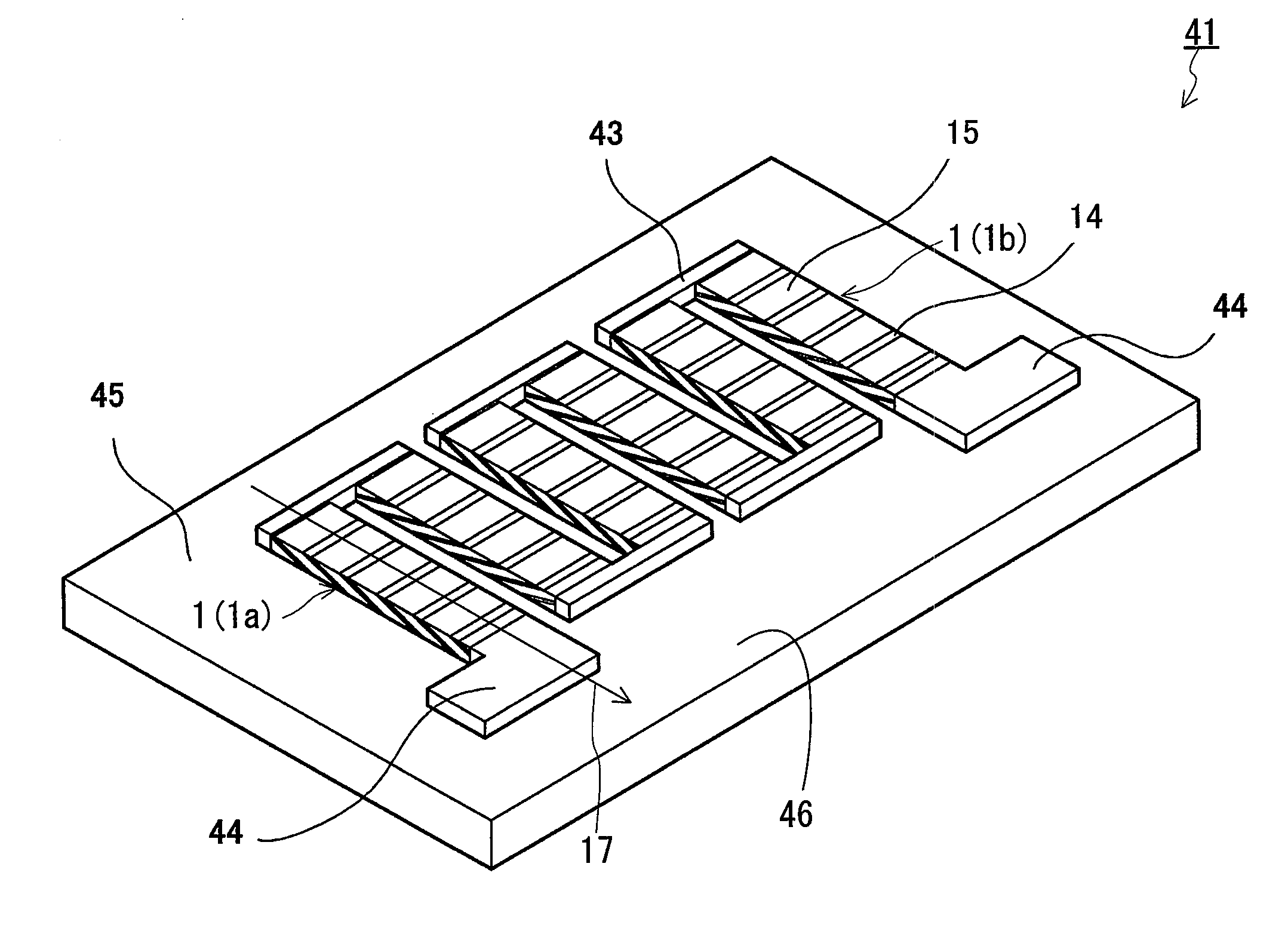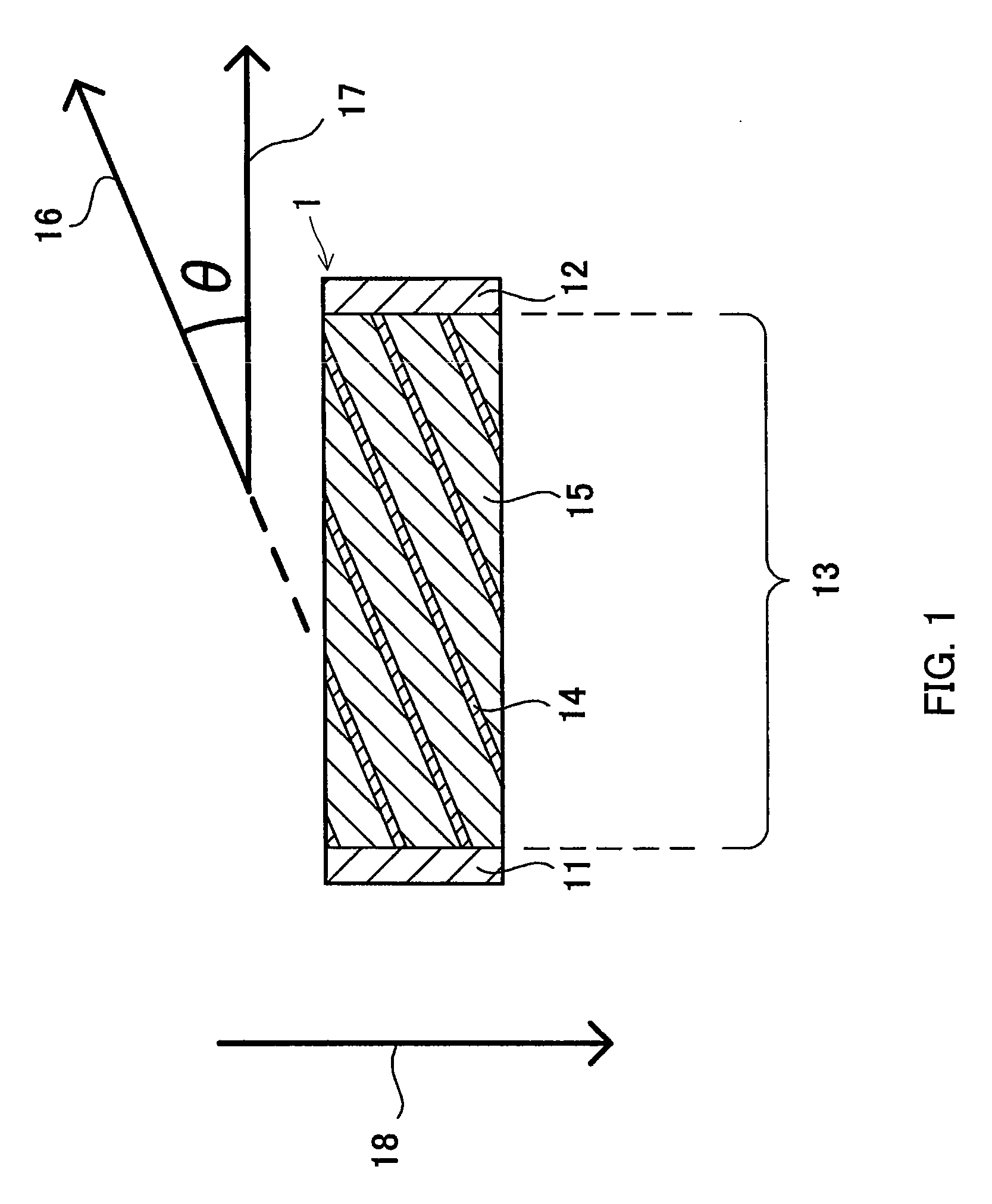Electric power generation method using thermoelectric power generation element, thermoelectric power generation element and method of producing the same, and thermoelectric power generation device
- Summary
- Abstract
- Description
- Claims
- Application Information
AI Technical Summary
Benefits of technology
Problems solved by technology
Method used
Image
Examples
example 1
[0056]In Example 1, thermoelectric power generation elements 1 as shown in FIG. 1 were produced using SrB6 and several types of metals (Au, Ag, Cu and Al), and then the thermoelectric power generation characteristics thereof were evaluated.
[0057]First, a metal foil (Au foil, Ag foil, Cu foil, or Al foil) with a size of 100 mm×100 mm and a thickness of 20 μm was prepared, and a 2.0-μm thick SrB6 film was formed on each surface of the metal foil by the sputtering method.
[0058]Next, a sheet of a SrB6 film / a metal foil / a SrB6 film formed as described above was cut into a size of 50 mm×50 mm to form small strip pieces. Two hundred small pieces thus formed were superimposed together and were subjected to heat pressure bonding at 250° C. for one hour under a reduced pressure of 10−4Pa while a load of 100 kg / cm2 was applied in the direction in which they were laminated. Thereafter, it was subjected to cutting and polishing and thus a laminated original plate with a size of 3 mm×48 mm and ...
example 2
[0064]In Example 2, Ag or Cu was used as the metal for forming a metal layer and elements with different thickness ratios between the metal layer and the SrB6 layer from one another were produced in the same manner as in Example 1. While the inclination angle θ was fixed at 30°, the thickness of the metal foil used for forming the element was changed to 40 μm, 50 μm, 60 μm, 70 μm, 80 μm, 90 μm, 95 μm, 98 μm, and 99 μm, and the elements were formed so that the lamination cycle of the metal layer and the SrB6 layer was 100 μm. The thickness ratios of the SrB6 layers to the laminates of the elements thus formed were 60%, 50%, 40%, 30%, 20%, 10%, 5%, 2%, and 1%, respectively.
[0065]With respect to the elements thus produced, the power factors thereof were evaluated in the same manner as in Example 1. The results thereof are indicated in Table 2.
TABLE 2[Change in power factor (μW / (cm · K2)) of elements accordingto thickness ratio of SrB6 layer to laminate]Thickness ratio of SrB6layer to l...
example 3
[0067]In Example 3, while Cu was used as the metal for forming the metal layers, and elements that were different in the thickness ratio between the metal layer and the SrB6 layer and inclination angle θ from one another were produced in the same manner as in Example 1. The inclination angle θ was changed at 50 intervals from 10° to 50°, the thickness of each Cu foil used for forming the elements was fixed at 20 μm, the thickness of the SrB6 film formed on the surface of the Cu foil was changed to 0.25 μm, 0.5 μm, 1 μm, 2 μm, 4 μm, and 8 μm. Thus elements were formed.
[0068]With respect to the elements thus produced, the power factors thereof were evaluated in the same manner as in Example 1. The results are shown in Table 3 below.
TABLE 3[Change in power factor (μW / (cm · K2)) of element in termsof inclination angle θ and thickness ratio of SrB6 layer to laminate:metal forming metal layer (thickness of 20 μm) was Cu]Inclination angle θ101520253035404550Thickness of SrB68 (μm) / 23303232...
PUM
 Login to View More
Login to View More Abstract
Description
Claims
Application Information
 Login to View More
Login to View More - R&D
- Intellectual Property
- Life Sciences
- Materials
- Tech Scout
- Unparalleled Data Quality
- Higher Quality Content
- 60% Fewer Hallucinations
Browse by: Latest US Patents, China's latest patents, Technical Efficacy Thesaurus, Application Domain, Technology Topic, Popular Technical Reports.
© 2025 PatSnap. All rights reserved.Legal|Privacy policy|Modern Slavery Act Transparency Statement|Sitemap|About US| Contact US: help@patsnap.com



